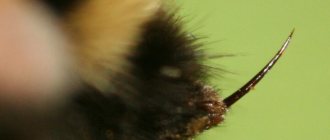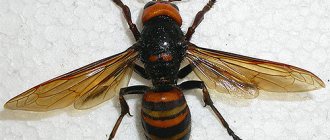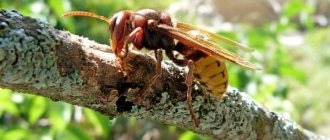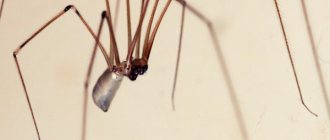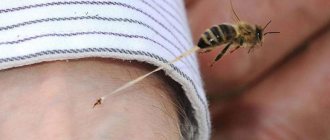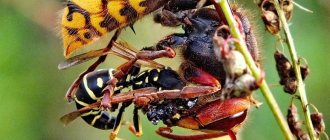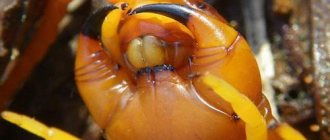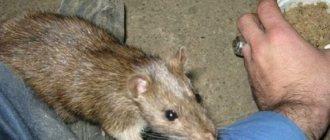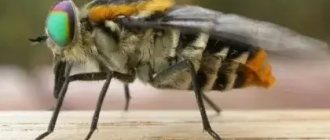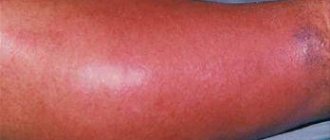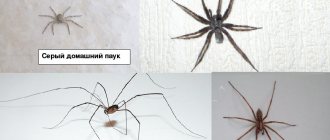Bumblebees are much more peaceful than many insects, even their closest relatives - bees.
But this does not mean that an encounter with a large, hairy insect is guaranteed to be without trouble. If you behave incorrectly, it is quite possible to provoke an attack and a bumblebee bite. You need to know how to act in this situation to avoid negative consequences.
Features of a bumblebee sting
Not every bumblebee can sting. The queen and working females have a sting, but nature has not endowed male bumblebees with this weapon. Despite the close family ties between bumblebees and bees, their sting is more like that of a wasp. It is absolutely smooth, without serrations that interfere with its release from the victim’s skin after a bite. This is why an insect can sting repeatedly without causing any harm to itself.
The inside of a bumblebee's sting is hollow. At the moment of the bite, poison passes through the canal and enters the victim’s blood.
Sexual differences, reproduction
Sexual dimorphism is expressed implicitly. The sizes of females and males differ little. Features of female and male individuals relate to the appearance and structure of the body. Examples:
- the head of females is elongated, and that of males is round or triangular;
- males have a powerful mouthparts, while females have a rectangular upper lip and curved mandibles;
- in females, the abdomen ends in a smooth, multi-acting sting, and in males, instead of a stinger, the genitals are covered with a layer of chitin;
- On the hind legs of females there is a “basket”, that is, a place surrounded by hairs for collecting pollen grains.
Bumblebees reproduce through complete metamorphosis in nature. Insects go through 4 stages of development: egg, larva, pupa and adult. Fertilization of the uterus in the family occurs in the fall. Life cycle:
- Preparation for nesting - the fertilized queen flies out in the spring after wintering and looks for a suitable place.
- Set up the nest over a period of several weeks and place a wax bowl with nectar at the entrance.
- Laying elongated eggs of 8–16 pieces - before this, the queen creates a cushion of pollen and beebread, covered with wax, in the middle of the nest.
- The larvae emerge in 4–6 days - they stretch and break through the wax shell, and the female and her toilers constantly repair this layer.
- Pupation after 1.5–3 weeks - the larvae weave a cocoon, and the queen again creates an accumulation of pollen with beebread and lays another dozen eggs.
- Emerging from the cocoons after 10–19 days - the young animals gnaw through the shell; the empty cells are not disposed of in the family, but are left for storing honey.
The first offspring appears after 3–4 weeks. The emerging young become working bumblebees. They take on the responsibilities of the queen, while the female stops leaving the nest, but only lays eggs and helps feed the larvae. Insects do not use cells twice to rear brood, but build new devices each time.
The danger of a bumblebee bite
Having decided on the question of whether bumblebees bite, understanding that you need to be wary of females, you still shouldn’t be afraid of meeting them. However, it is better to behave carefully so as not to cause insect aggression.
Bumblebee sting
A bumblebee sting is quite painful, but does not pose a particular threat to the vast majority of people. It is dangerous only for allergy sufferers and people whose immune systems are not functioning properly.
In addition to an allergic reaction, the bite can cause itching. When scratching, dirt can get into the wound, which can cause infection.
First aid for a bite
Treating a bumblebee bite
The most important question that interests many people is: how to treat bumblebee bites. Actions usually depend on the severity of the consequences of the bite:
- If a sting is visible in the bitten area, it should be pulled out with tweezers, previously disinfected.
- Then this area must be anointed or treated with an antiseptic by applying a swab with alcohol, hydrogen peroxide or a solution of potassium permanganate; there is no need to make efforts to squeeze out the poison so as not to introduce infection into the wound.
- Applying a cold compress will help reduce swelling and relieve pain.
- Drink an antihistamine to relieve a possible allergic reaction, even if there is no predisposition to it: Suprastin, Erius, Zodak, etc.
- In the following hours, it is necessary to increase fluid intake (water and tea with sugar), which will reduce the likelihood of a toxic reaction.
- If the patient's condition worsens, it is better to call a doctor.
When stung by a bumblebee, it is prohibited:
- try to slam or crush the insect, because toxic substances released will attract the rest of the colony;
- comb the bitten area;
- take sleeping pills or alcohol.
On a note!
To prevent the poison from spreading to adjacent areas of the skin, it is necessary to avoid scratching and rubbing in the area of bumblebee bites. It is also not recommended to consume alcoholic beverages and take hot baths, as this can cause vasodilation and a wider distribution of toxic toxins in the victim’s body.
Do the bites of different types of bumblebees differ?
The composition of bumblebee venom may vary slightly depending on the species of the insect. The same factor largely influences the likelihood of an attack, as well as the painfulness of the bite. The most common types of bumblebees:
- garden - a small insect (up to 22 mm), non-aggressive, rarely bites, the bite is not very painful;
- black carpenter bumblebee - an insect with a black body and violet-blue wings, bites to protect the nest or in defense, the bite is quite painful;
- ground bumblebee - lives underground, preferring burrows left by rodents, bites very rarely;
- stone bumblebee - rather large insects (up to 3 cm) build nests in piles of stones; the poison can cause severe allergies.
City and field bumblebees also bite infrequently, the pain of the bite is moderate.
Sexual differences and reproduction
In the bumblebee family, individuals are divided into several types, differing anatomically and in function:
- uterus;
- workers;
- males;
- females.
The queen is a female born last summer and fertilized in the fall, who builds her nest and creates a new family. From the eggs laid by it, larvae emerge, which turn first into pupae (they do not feed), then into workers. When the workers become able to fly and bring pollen, the queen remains in the nest and is engaged in laying eggs and caring for the larvae.
Working individuals are underdeveloped females. They bring nectar, make honey and feed larvae. Their size is smaller than that of males and females, and their lifespan is from 1 to 3 months. Males and females develop from larvae in the second half of summer to produce fertilization in the fall. Males do not bring nectar, but, unlike bee drones, they feed on flowers on their own.
During the mating season, the male flies around the trees along a certain route, marking the bark, leaves, and flowers. He bites them and marks them with the secretion of the odorous gland. The female finds the marks and waits for the male near them. He periodically returns to his marks, finds a female and copulation occurs. In other species, the male simply waits for the female at the exit of her nest. Then the males die, and the females remain to spend the winter.
In addition to species-specific ones, there are main sexual differences between bumblebees:
- females are always larger;
- males and females differ in the number of antennal segments and the number of abdominal segments;
- females are equipped with a sting.
Symptoms and appearance of the bite
After a person is stung by a bumblebee, the following symptoms are most often observed:
- sharp, rather severe pain, burning;
- compaction at the site of the bite;
- swelling.
The bumblebee bite itself looks like a red dot, around which the skin swells and turns red. The intensity and area of swelling and redness depend on the individual characteristics of the bitten person, as well as the period after which all traces will disappear. For some, everything goes away in a matter of hours, for others, healing is delayed for weeks.
Interesting facts about the bumblebee
Incredibly, just one field bumblebee visits more than 2,600 flowers during a 100-minute flight! But this is far from the most surprising fact associated with insects.
- Bumblebees can reach speeds of up to 18 km/h. This is quite an impressive indicator for a Hymenoptera.
- The fur that covers the bumblebee's body is designed to reduce the insect's heat loss by half.
- During the flight period, 90% of the bumblebee's energy is converted into heat. Therefore, a flying bumblebee has a body temperature close to normal human body temperature.
- A bumblebee family is called a colony. The number of colonies can differ sharply: one contains 50 bumblebees, while another contains about two hundred.
- The female insect lays from 200 to 400 “worker” eggs - from which worker individuals are born. And immediately after this it begins laying eggs for the reproduction of queens and males.
- The cuckoo bumblebee is a well-known pest that can mimic the color of any beneficial species of its fellows in order to lay its own eggs in the hive.
- Bumblebees do not pollinate, but after collecting nectar, pollen residues can cling to the abdomen of the insect and thus move to another flower.
After the larva leaves the wax cell of the hive, this niche begins to be used exclusively for storing nectar. The same cell is never used repeatedly to raise offspring.
Localization of bites and greatest danger
The greatest danger from a bumblebee bite is if it strikes the neck or face. Swelling that develops after a bite to the neck can cause breathing problems. If an insect stings near the eye, in the lip, tongue or nasal mucosa, severe swelling makes it difficult for the affected organs to function normally. It is least dangerous if a bumblebee stings your finger, leg or arm.
shemale face
Morphological description of the species
The moss bumblebee (Bombus muscorus) belongs to the order Hymenoptera, the family of true bees, and the genus Bumblebee. Insects are medium-sized; the dimensions of an individual depend on its hierarchy in the family. The body length of the uterus is 17-18 mm, workers - 10-15 mm, males - 14-15 mm. A characteristic feature of the species is the uniform coloring of the back and abdomen. The dorsum is covered with reddish or yellow hairs, the abdomen is yellow, but stripes corresponding to the tergites are noticeable.
The head of females is elongated, with a wide nape. Lateral parts of clypeus covered with sparse yellow hairs. There are dense hairs of the same color on the forehead. In addition to well-developed compound compound eyes, it has 3 simple ocelli. Their upper part is located in line with the top of the main organs of vision. The antennae are 12-segmented. The upper part of the chest is yellow-brown or brownish. On the sides and bottom the color is lighter.
As you can see in the photo, the limbs of female moss bumblebees have a special apparatus for collecting pollen. Spurs and long hairs on the hind tibia form a “basket”.
Working female moss bumblebee
Males have a triangular head and antennae consisting of 13 segments. The back of the bumblebee is yellow, with a small admixture of dark hairs. The abdomen consists of 7 tergites. The male does not have a stinger, but has a claw-like copulatory organ.
Relieving swelling
Bumblebee venom, once in the blood, spreads throughout the body. The immune system responds to a foreign substance by producing antibodies. They react with the toxin, resulting in the formation of new chemical compounds. They penetrate into the tissues, disrupt microcirculation, as a result of which fluid accumulates in the tissues - swelling is formed.
The best way to reduce swelling is to cool the affected area. You can also use folk or medicinal decongestants.
What do bumblebees eat?
Representatives of the bumblebee genus collect pollen and nectar from many plant species, that is, they are polytrophic. To feed the larvae, bumblebees use not only fresh nectar, but also honey, which they make themselves. Bumblebee honey is thinner than bee honey, lighter and lighter, less sweet and fragrant. It contains more than 20% water and does not store well.
Photo credit: Ivar Leidus, CC BY-SA 4.0
Treatment
Most people do not need special treatment after a bumblebee bite; all symptoms go away on their own in a fairly short time. And yet, to reduce pain, relieve redness and swelling, you can use medications and folk remedies.
Folk remedies
Our distant ancestors knew what to do after a bumblebee bite. Much of their advice is still relevant today. The following will help reduce discomfort:
- chopped plantain, parsley;
- aloe juice or freshly cut leaf;
- compress of grated onions;
- a slurry of soda mixed with water;
- lemon juice;
- a slice of fresh cucumber, lemon, sour apple, potato;
- chamomile decoction;
- a mixture of honey and chopped garlic.
Alcohol tincture of calendula or olive oil will help relieve swelling and redness.
Pills
To help a person bitten by a bumblebee, tablets, as strange as it may sound, are most often used externally. It is necessary to dissolve a tablet of activated carbon, aspirin or validol in water, and then moisten a cotton pad in the solution and apply it to the wound. This will soothe the pain and relieve swelling.
Antihistamines are taken internally: Suprastin, Tavegil, Citrine and others.
Ointments
Ointments and gels reduce burning, relieve redness and swelling. The most effective:
- Fenistil gel;
- Menovazin;
- balm “Star”;
- Rescuer;
- Psilo-balm;
- Levomekol.
Levomekol
Attention! It is strictly not recommended to use hormonal ointments without a doctor’s prescription.
Prevention
bumblebee nest
To avoid unpleasant encounters with bumblebees, you should know some rules. The instructions below will help you prevent these insect bites.
- The best way to avoid being bitten by bumblebees is to stay away from their habitats. Under no circumstances should you destroy the nests of these insects, as there is a possibility of falling under the wrath of an entire swarm.
- There is no need to walk barefoot on the grass, as you may inadvertently step on an insect hiding in the grass.
- If a bumblebee is flying near you, do not try to scare it away with sweeping movements. There is also no need to run away from the insect, this will attract its attention even more.
- Avoid bright clothes and strong perfumes when traveling outside the country.
- In summer and spring, use mosquito nets.
- Prevention also includes having a first aid kit equipped with everything necessary to provide first aid and knowledge of the dangers of bumblebee bites and what to do if you are bitten.
Video on the topic
How dangerous is an allergic reaction?
The bumblebee is dangerous because at the time of the bite it injects a toxic substance into the wound, which causes intoxication of the body. But the main health threat is a possible allergic reaction to the toxin. The degree of intensity may vary depending on the individual characteristics of the person. Allergy symptoms:
- extensive swelling extending far beyond the affected area;
- the appearance of a rash on the body;
- nausea, vomiting;
- diarrhea;
- difficulty breathing, suffocation;
- heart rhythm disturbance;
- fever, chills.
In severe cases, convulsions, loss of consciousness, and anaphylactic shock are observed.
An allergic reaction to bumblebee venom that enters the body may not appear immediately, but usually it occurs quite quickly within a maximum of 1.5 hours after the bite.
Does a bumblebee sting people and why?
Bumblebee bite
Unlike bees, bumblebees bite only in self-defense, attacking someone who poses a threat to him or is trying to destroy the hive or his family's supplies.
The following can also provoke an insect attack:
- pungent odor of cosmetics or perfumes, alcohol or fumes, oxidizing metal;
- blue color in clothing or sudden movements of a person.
Important!
The greatest danger is posed by multiple bumblebee bites, due to the large volume of toxins entering the blood, which can cause a severe toxic reaction, accompanied by disruption of the human cardiovascular and nervous system. There is also a possibility of death if anaphylactic shock occurs and the victim stops breathing.
When is a doctor needed?
In some situations, a person’s life after a bumblebee bite is in serious danger and only qualified medical assistance can help. Consultation with a doctor is required in the following cases:
- the insect stung a small child, a pregnant woman, a person with a predisposition to allergies;
- bite site - face, neck;
- multiple bites;
- a person experiences symptoms of intoxication (severe, rapidly spreading swelling, nausea, lethargy, dizziness, loss of consciousness).
A doctor’s help is also needed if the wound becomes infected, when the affected area becomes inflamed and suppuration appears.
Family life
Having chosen a place for the nest, the female builds the first wax cell into which she lays several eggs. She also collects nectar and pollen to feed the larvae, putting the compacted food in other cells.
When the larvae turn into adult workers, providing the family with food becomes their responsibility, and the queen almost never leaves the nest, breeding new generations of bumblebees. The total number of insects in one family is several hundred individuals. Male rearing begins in mid-summer. Interestingly, some working individuals can also lay unfertilized eggs for this purpose. Young males leave the nest and lead a solitary life while waiting for the young females to fly out.
Feeding bumblebee brood
At the end of summer, the bumblebee family hatches full-fledged females, who will become the founders of new families. After the emergence of new queens, the activity of the families decreases: they stop storing nectar and repairing cells, the number of insects gradually decreases, and with the cold, the life of the majority ends. Young queens dig holes in the ground and hibernate.
How to prevent bumblebee bites?
Following some recommendations will help to significantly reduce the risk of being stung by a bumblebee:
- you should not try to catch an insect or drive it away by waving your arms;
- it is undesirable to be near a bumblebee nest, much less perform any manipulations with it;
- Don’t eat sweets outside that attract insects;
- When in nature, it is better to dress in clothes of soothing colors and not use perfumes with a cloying, pungent aroma.
If bumblebees appear on your property from time to time, you should not immediately think about how to get rid of them. Peaceful coexistence with these insects is quite possible.
Color “varieties”
The easiest way, according to experts, is to distinguish hairy insects by the color of the bristles, as well as the color of the characteristic features of the body structure. Below we will talk about what honey collectors are like from this point of view.
- Painted in alternating yellow, black and white colors:
- garden;
- small earthen;
- underground.
- With a visible dark stripe on the back, a burgundy end of the abdomen and a basic gray-yellow tint:
- steppe;
- forest.
- Bright yellow, with a spot or dark stripe between the wings:
- carder;
- spotted back.
- Gray with a visible black stripe on the back:
- field;
- urban.
- Pure black interspersed with red - at the end of the abdomen:
- stone;
- small stone;
- horse.
- Yellow-red:
- volatile;
- moss.
Enemies of bumblebees in nature
Ants cause great harm to bumblebees. They steal honey from the female incubating the eggs and steal eggs and larvae. Bumblebees cannot fight this small and numerous predator and therefore build their nests above the ground, away from anthills, and also underground, in rodent burrows with long passages, where it is difficult for ants to get through.
Some species steal bumblebee honey (paper wasps) or eat brood (German wasps). Brachycoma flies do the same. Conopid flies pose a great danger to bumblebees: they chase the bumblebee in the air, stick an egg to it in flight, from which a larva emerges and eats its host. The bumblebee offspring of the moth moth caterpillar is destroyed. Female bumblebees are infested by the parasitic worm Spherularia nematode, as a result of which the insects die even before the nest is laid. Parasitic hyphomycete fungi also kill female bumblebees during their wintering in the turf. Gamasid mites are common in bumblebee nests. Among birds, the bumblebee's enemy is the golden bee-eater. The bird causes significant damage to bumblebee populations by pecking insects that collect nectar. Bumblebee nests are destroyed by foxes, hedgehogs and dogs. Great harm to bumblebees is caused by parasites and parasites - cuckoo bumblebees, related to real bumblebees.
Photo credit: André Karwath, CC BY-SA 2.5
Measures to prevent bumblebee bites
The bumblebee cannot be classified as an aggressive insect, such as a wasp or even a honey bee. Cases of bumblebee bites are very rare . While collecting nectar, the insect does not react to the presence of a person. They will not pay any attention if people accidentally touch a flower on which a bumblebee is sitting. An insect attack is possible only for the purpose of self-defense or protection of the nest. Therefore, in order not to provoke a bumblebee attack, you need to follow simple recommendations:
- deliberately not touching the insect;
- without proper ammunition, do not enter an apiary or other places where there is a lot of nectar or honey;
- stop eating and preparing food on the street;
- during the season when bumblebees are especially active, install mosquito nets on doors and windows;
- do not wave your arms or make sudden movements if a bumblebee flies nearby;
- be careful during summer walks in parks, gardens and summer cottages;
- do not wear bright clothes when traveling outdoors;
- when working in the garden or vegetable garden, wear closed clothing;
- when relaxing in the fresh air, a person should not smell strongly of alcohol or sweat;
- do not spray perfumes with strong aromas, do not use lotion or other cosmetic products with a strong smell when traveling out of town.
Interesting: Is it possible to give sweets to domestic rabbits?
Bumblebees are also irritated by the smell of oxidizing metal , which occurs when the skin comes into contact with, for example, a ring, bracelet, metal watch strap and other jewelry.
Where do bumblebees live in nature?
Bumblebees live on all continents except Antarctica. In the Northern Hemisphere, they are distributed mainly in temperate latitudes, but the habitat of some species extends beyond the Arctic Circle (for example, the polar bumblebee (lat. Bombus polaris), the northern bumblebee (lat. Bombus heperboreus)). They are found in the tundra, Chukotka, Alaska, Novaya Zemlya, Spitsbergen, Greenland and other Arctic islands located less than 900 km from the North Pole. Bumblebees can be found high in the mountains - in alpine meadows, at the very boundaries of glaciers in all the main mountain systems of the world (Lapland bumblebee (Lat. Bombus lapponicus), Baltic bumblebee (Lat. Bombus balteatus), etc.). Preferring cooler areas, bumblebees are rarely found in the tropics: 2 species in the Amazon (Bombus atratus and Bombus transversalis) and several species in tropical Asia. In South America, except for the Amazon, they are widely distributed in temperate latitudes. The ground bumblebee (lat. Bombus terrestris) lives in North-West Africa, but in the south, in hot deserts and in the tropics, there are no representatives of the bumblebee genus. Bumblebees live in many areas of Asia. It is believed that Asia is the birthplace of all bees.
At the beginning of the twentieth century, underground (lat. Bombus subterraneus) and garden bumblebees (lat. Bombus hortorum) were brought from England to Australia and New Zealand to pollinate clover. Several species of bumblebees currently fly in New Zealand (Bombus terrestris, Bombus hortorum, Bombus subterraneus, Bombus ruderatus). In Australia, bumblebees live only in the state of Tasmania, and they are prohibited from being introduced into other states or imported from other countries.
Photo credit: Andreas Schmitt, CC BY-SA 3.0
Bumblebees are the most cold-resistant members of the true bee family. The ability of bumblebees to survive in cold areas and their dislike for the hot tropics are associated with the peculiarities of their thermoregulation.
The body temperature of a bumblebee can reach 40 degrees, exceeding the ambient temperature by 20-30 degrees. This increase occurs due to the fact that the bumblebee quickly contracts its chest muscles without moving its wings. This is precisely the source of the loud buzzing noise coming from the insect. That is, when a bumblebee hums or buzzes, it warms up. Stopping moving, the insect begins to cool down.
Photo credit: Tim Felce (Airwolfhound), CC BY-SA 2.0
Does a bumblebee attack a person?
Wasp, bee, bumblebee, hornet - differences
Seeing a large bee-like insect, many people get scared, not knowing whether bumblebees bite people. On their own initiative, they do not attack a person unless there are aggressive actions on his part. Having seen a bumblebee nest near their home, many try to get rid of the insect, not only by fumigating them with smoke, but also by destroying the “houses”.
Note! You should not try to catch bumblebees with your hands. Even the male is able to stand up for himself, biting through the palm with his sharp jaws.
Can a bumblebee bite a person on its own initiative? This is possible in 2 cases:
- if the clothes are blue, for some reason this shade is dangerous for insects; therefore, one can expect an inadequate reaction; although the sting practically does not pierce the fabric itself, the insect can injure an open area of the body;
- Bumblebees are aggressive towards the smells of alcohol, fumes, perfumes and tobacco; this can become a reason for an attack by a whole swarm of insects that find themselves in close proximity.
Sometimes bee relatives are irritated by the smell of oxidized metal. This “aroma” of the body arises from constantly wearing watches with bracelets and jewelry. The metal oxidizes under the influence of sweat secreted by the skin, which is quite typical for the hot season.
Bumblebees are also attracted by the smell of fried meat, watermelons, melons, and sweet drinks. Therefore, it is not recommended to have picnics near insect homes, so as not to brush off the annoying invasion later. This unnerves the bumblebees and can become a reason for an attack.
Bumblebees are also attracted by the smell of fried meat, watermelons, melons, and sweet drinks.
If a person does suffer, it is advisable to take immediate action, even if there is no tendency to allergies:
- apply fresh parsley or plantain leaf to the injured area, changing the compress every 2 hours until the swelling subsides;
- Dressings with pieces of apple, raw potatoes, onions mixed with honey help well;
- you can periodically treat the wound with lemon juice;
- Traditional healers recommend making compresses with soda solution, activated carbon slurry or validol.
If the bite is in a sensitive area (for example, in the eye area), it is better to use cold compresses or ice cubes. This will help relieve pain, relieve swelling and slow down the absorption of poison.
Additional Information. A compress using refined sugar moistened with water can remove bumblebee toxin from a wound.
You should not drink alcohol after a bite - alcohol will only intensify the allergic reaction. But hot sweet tea and plenty of liquid will be welcome.
In some cases, it is more rational to seek medical help:
- if several bumblebees are stung at once;
- when the bite was in the throat area, oral mucosa or eyeball;
- if an elderly person or child is injured;
- in the presence of severe pain, swelling, suppuration and chills.
Note! If the victim is allergic, after contact with a bumblebee you should not wait for the body’s reaction, but immediately consult a doctor.
It is most dangerous if there was not just one bite, but several individuals attacked
It is most dangerous if there was not just one bite, but several individuals. In this case, the amount of poison entering the body from the sting increases many times, and the internal systems have difficulty coping with intoxication.
Such situations are rare, because bumblebees usually do not attack in a flock. More often this happens if there have been attempts to destroy the insect nest. Even when it was accidentally touched, bumblebees will not figure it out; their self-preservation instinct turns on.
You should not hunt for wild honey produced by bumblebees - its taste is in many ways inferior to that of bees. But attempts at such penetrations can have disastrous consequences.
Whether a bumblebee stings or not, first of all, it depends on the people themselves. It is enough to keep your distance from these insects and not provoke contact with them. Bumblebees should not be harassed, given their value to nature - they are excellent plant pollinators. Experienced summer residents even deliberately breed a swarm next to greenhouses and hotbeds.
5 5 votes
Article rating
